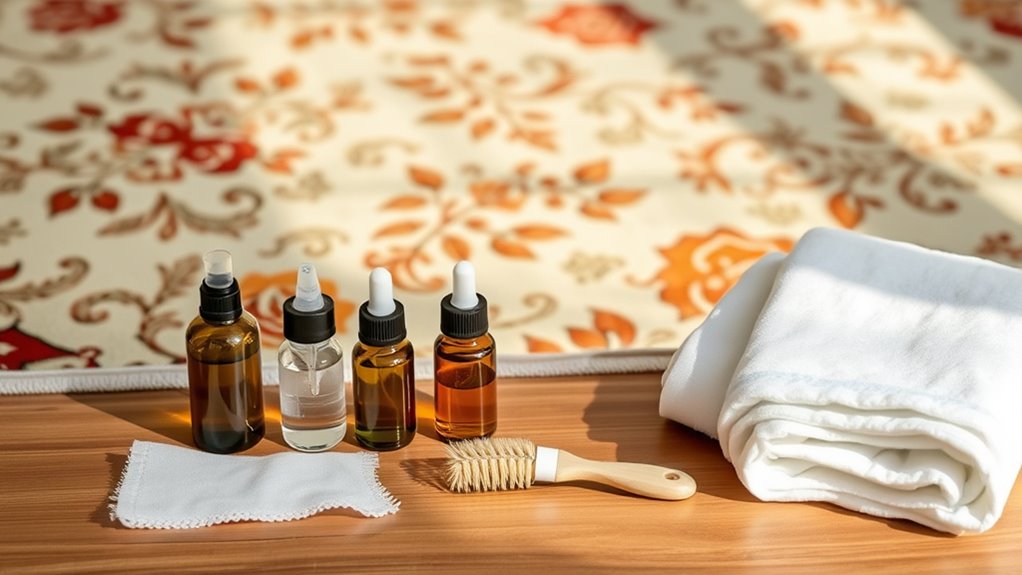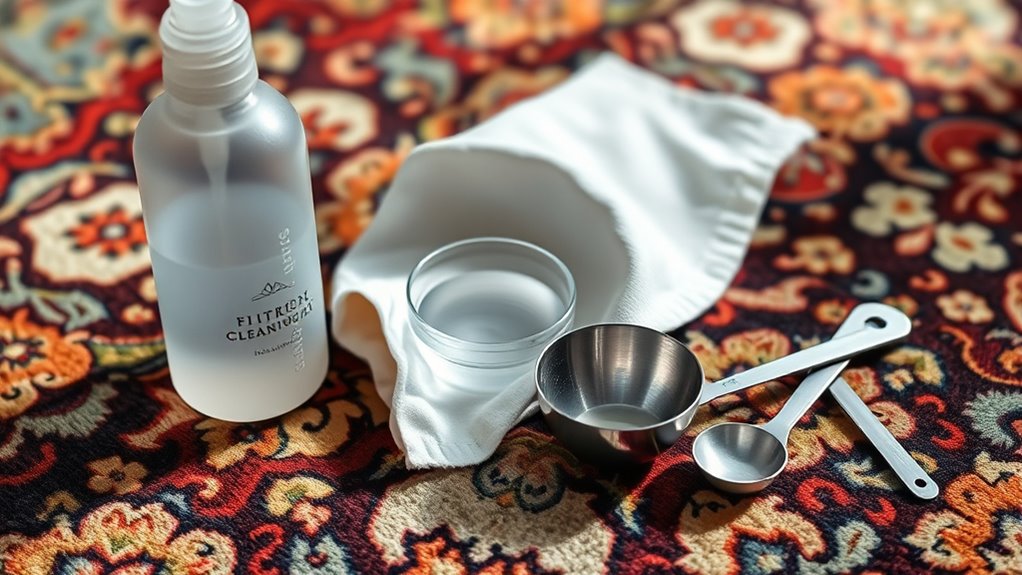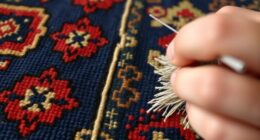To create an effective DIY spot-cleaning kit for your silk rug, gather soft cloths, a small spray bottle, cotton swabs, and a gentle brush. Use diluted white vinegar or a pH-neutral detergent for cleaning, applying sparingly and dab to lift stains. Test solutions first on hidden areas to prevent damage. Keep your kit organized and act quickly when spills happen. Curious for more tips? Continue exploring to keep your silk rug looking its best.
Key Takeaways
- Gather essential tools like microfiber cloths, spray bottles, cotton swabs, soft brushes, and absorbent towels.
- Use diluted silk-safe solutions such as white vinegar or pH-neutral detergent for targeted stain treatment.
- Apply cleaning solutions sparingly, dabbing gently to avoid fiber damage, and test on hidden areas first.
- Blot excess moisture with a damp cloth, pat dry with a soft towel, and avoid over-wetting to prevent stretching.
- Maintain the kit regularly, act quickly on stains, and follow gentle cleaning procedures to preserve silk rug quality.
Essential Items for Silk Rug Spot Cleaning

Silk rugs add elegance to any space, but their delicate fibers require careful cleaning—especially when spots happen. If you want to maintain their beauty without risking damage, creating a DIY spot-cleaning kit is a smart move. The key is to have the right tools and cleaning solutions on hand so you can act quickly and effectively. Stain removal on silk requires gentle, targeted approaches, so your kit should include items that won’t harm these fragile fibers. First, gather a soft, clean cloth or sponge—microfiber works well—since rough materials can fray or damage silk. You’ll also need a small spray bottle to apply cleaning solutions precisely. For stain removal, avoid harsh chemicals; instead, opt for mild, silk-safe solutions like diluted white vinegar or a gentle, pH-neutral detergent specifically formulated for delicate fabrics. These are effective yet gentle enough to prevent fiber damage. Keep a bottle of distilled water nearby for rinsing, as tap water can contain minerals or chemicals that might stain or weaken silk fibers over time. A few cotton swabs can help target stubborn spots in tight areas, ensuring you don’t over-wet the entire rug. To protect the surrounding area during cleaning, a few paper towels or soft cloths are essential—they help absorb excess moisture without rubbing or spreading the stain further. Consider adding a small, soft-bristled brush for gentle agitation if needed, but only if the silk fibers are resilient enough and the stain is stubborn. Always test your cleaning solutions on a hidden corner of the rug first to check for colorfastness. When stain removal becomes necessary, act quickly, applying the solution sparingly to the affected area. Dabbing gently is preferable to rubbing, which can damage the silk or push the stain deeper. Once the stain lifts, blot the area with a clean, damp cloth to remove any residual cleaning solution, and then gently pat dry with a soft towel. Remember, patience is critical with silk—over-aggressive cleaning can cause permanent damage. Proper care and maintenance can help prevent future stains and preserve the rug’s original luster. Cybersecurity vulnerabilities during incidents like the Microsoft outage highlight the importance of having contingency plans in place. Keep your kit organized and accessible, so whenever a spot appears, you’re ready to respond immediately with the proper tools and solutions. Being aware of color accuracy and how to maintain it can safeguard your silk rug’s natural hues and luster over time. Additionally, understanding the health benefits of fruit juices can inspire a balanced approach to home care and nutrition, promoting overall well-being. This proactive approach not only helps preserve the delicate fibers but also extends the life and beauty of your silk rug, ensuring it remains a stunning centerpiece in your home for years to come.
Frequently Asked Questions
Can I Use Regular Carpet Cleaners on Silk Rugs?
You shouldn’t use regular carpet cleaners on silk rugs because they can damage delicate fibers. Instead, focus on gentle stain removal methods tailored for silk. Regular carpet cleaning products often contain harsh chemicals that can cause discoloration or deterioration. Always test a small, hidden area first, and opt for a mild solution or professional cleaning to keep your silk rug looking its best without risking damage.
How Often Should I Spot Clean My Silk Rug?
Think of your silk rug as a delicate dance partner—you want to keep it graceful. You should spot clean it as soon as stains appear, ideally once a month, to prevent buildup. Use gentle cleaning methods to avoid damage and focus on stain prevention. Regular, light care keeps your silk rug vibrant and pristine, much like a well-rehearsed performance, ensuring it remains elegant for years to come.
Is It Safe to Use Vinegar on Silk Rugs?
Vinegar safety on silk rugs depends on how it’s used. While vinegar can sometimes help with stains, it’s important to dilute it properly to prevent damage. Using undiluted vinegar may harm the delicate silk fiber, risking discoloration or weakening. To preserve your silk fiber, always test a small area first and opt for gentle, silk-safe cleaning solutions. When in doubt, consult a professional to guarantee your rug’s safety.
What Should I Do if the Stain Persists?
When a stain refuses to budge, think of it as a stubborn guest at your door. You should try gentle stain removal techniques first, but if it still persists, it’s time to call in the professionals. They have the expertise and proper cleaning recommendations to handle silk rugs without damage. Remember, patience and professional help are your best allies in preserving your rug’s beauty and integrity.
Can DIY Cleaning Damage the Silk Fibers?
You might wonder if DIY cleaning jeopardizes fiber damage on silk rugs. While you can successfully clean small stains, improper techniques or harsh chemicals can cause fiber damage. Using the wrong cleaning solutions increases the risk of weakening silk fibers, leading to potential deterioration over time. To avoid this, carefully follow instructions and test on a small area first. When in doubt, consulting a professional ensures your silk rug stays beautiful and intact.
Conclusion
Remember, treating silk rugs with care isn’t just about cleaning—it’s about preserving their beauty for generations. Some believe gentle, natural solutions are better, and studies show they often are. By using this DIY kit, you trust in simple, effective methods that respect your delicate rug’s fibers. So, approach each spill as an opportunity to protect your investment, proving that patience and proper care truly make a difference in maintaining your silk rug’s timeless elegance.









